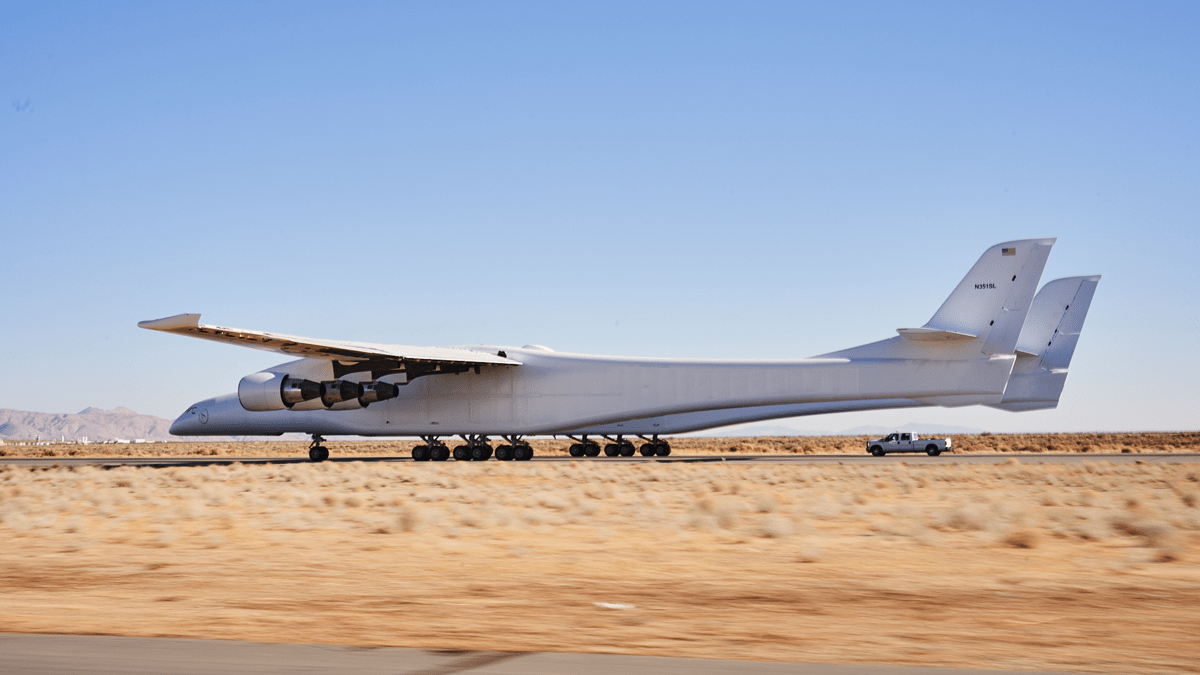In 2011,
Stratolaunch Systems
was founded with a simple goal: to reduce the costs of rocket launches by creating the world's largest air-launch-to-orbit system. Similar to Virgin Galactic's
SpaceShipTwo
, this concept involves a large air carrier - Scaled Composites Model 351 (aka. the "Roc") - deploying rockets from high altitudes so they can deliver small payloads to Low-Earth Orbit (LEO).
Recently, the aircraft reached a major milestone when it conducted its second taxi test at the
Mojave Air and Space Port
. The test consisted of the aircraft rolling down the runway at a speed of 74 km/h (46 mph) in preparation for its maiden flight. The event was captured on video and posted to
by Stratolaunch Systems (and Microsoft) co-founder Paul Allen, who was on hand for the event.
The Roc is essentially two 747 hulls mated together, making it the largest aircraft in the world - spanning 117 meters (385 ft) from one wingtip to the other and weighing 226,796 kg (500,000 lbs). It is powered by six Pratt & Whitney turbofan engines, giving it a maximum lift capacity of up to 249,476 kg (550,000 pounds). This would allow it to air-launch rockets that could deploy satellites to Low-Earth Orbit (LEO).
?ref_src=twsrc%5Etfw&ref_url=https%3A%2F%2Fwww.theverge.com%2F2018%2F2%2F28%2F17062872%2Fstratolaunch-worlds-biggest-airplane-test-videoLoading tweet...
— View on Twitter
As with other alternatives to rocket launches, the concept of an air-launch-to-orbit system is a time-honored one. During the early days of the Space Race, NASA relied on heavy aircraft to bring experimental aircraft to high altitudes (like the
Bell X-1
) where they would then be deployed. Since that time, NASA has partnered with companies like
Orbital ATK
and the
Virgin Group
to develop such a system to launch rockets.
However, the process is still somewhat limited when it comes to what kinds of payloads can be deployed. For instance, Orbital ATK's three-stage
Pegasus
rocket is capable of deploying only small satellites weighing up to 454 kg (1,000 pounds) to Low-Earth Orbit (LEO). Looking to accommodating heavier payloads, which could include space planes, StratoLaunch has created the heaviest commercial airlift craft in history.
Back on
May 31st, 2017
, the aircraft was presented to the world for the first time as it was rolled out of the company's hangar facility at the
Mojave Air and Space Port
in California. This presentation also marked the beginning of several tests, which including fueling tests, engine runs, and a series of taxi tests. The engine testing took place in
September, 19th, 2017
, and involved the aircraft starting it's six Pratt & Whitney turbofan engines.
The testing followed a build-up approach that consisted of three phases. First, there was the "dry motor" phase, where an auxiliary power unit charged the engines. This was followed by the "wet motor" phase, where fuel was introduced to the engines. In the final phase, the engines were started one at a time and were allowed to idle.
This test was followed in
December 18th, 2017
, with the aircraft conducting its first low-speed taxi test, where it traveled down the runway under its own power. The primary purpose of this was to test the aircraft's ability to steer and stop, and saw the aircraft reach a maximum taxing speed of 45 km/h (28 mph). This latest test almost doubled that taxing speed and brought the aircraft one step closer to flight.
The aircraft's maiden flight is currently scheduled to take place in 2019. If successful, the Roc could be conducted regular satellite runs within a few years time, helping to fuel the commercialization of LEO. Alongside companies like
SpaceX
,
Blue Origin
, and the Virgin Group, StratoLaunch will be yet another company that is making space more accessible.
Further Reading: The Verge
 Universe Today
Universe Today
